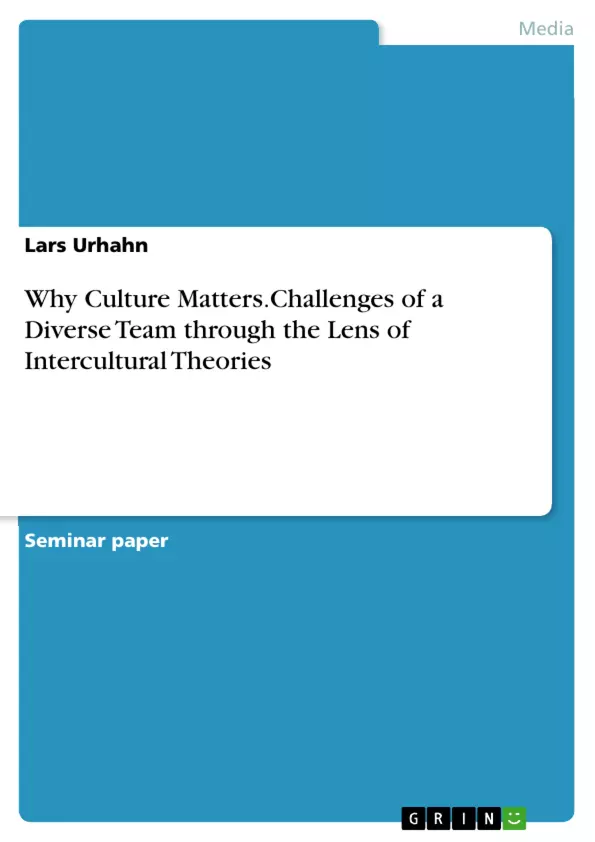“Culture” has become so broad a term that it is almost impossible to find the right angle or an allencompassing example to begin this article with. Although, Hall stated that “culture is a word that has so many meanings already that one more can do it no harm” it is not the aim of this article to contribute yet another “meaning”. Rather than adding to the vast amount of research on what “culture” is and where it comes from this article aims at making the case for why culture matters and how it can be properly analysed. The view put forth in this vein suggests that the analysis of cultural issues which lies at the heart of intercultural communication is one of the most important scientific endeavours of contemporary times. Prior to elaborating on the details of this endeavour it is necessary to address two crucial facts that emphasize the relevance of the applied approach as well as of intercultural communication in general. First, as numerous researchers and scholars have repeatedly pointed out the globalisation is expected to continue at even faster rate than before. As a result of immigration that comes along with the process of globalisation – and that will continue to come along despite current efforts to restrict it – Western societies will undergo severe changes. Evolving concepts such as “super” or “hyper diversity” acknowledge this development and will contest the way societies and nations are perceived. It is beyond doubt, that a more sophisticated understanding of cultures is essential the more the globalisation shapes every aspect of modern life. If an increasingly diverse world will eventually lead to a “clash of civilizations” or to their ultimate “fusion” has to remain unanswered. What both outlooks have in common, however, is that they rely on intercultural competence in some ways. Whether to avoid cultural conflicts or to contribute to a so-called “supra- culture” intercultural competence is the key to unlock the potentials of diversity. To sum up, the more the globalisation – and in particular its cultural by-products – impact virtual all levels of societies the more cross-cultural cooperation and therefore intercultural competence is needed. In order to succeed in building up this competence, however, knowledge has to be acquired through the meticulous analysis of cultural issues. This article is an attempt to fulfil that ambition.
Inhaltsverzeichnis (Table of Contents)
- Introduction
- Critical Incidents
- What are ͞ĐritiĐal iŶĐideŶts͟?
- Critical incident: cultural challenges in a diverse team – international university students working on a group-based project
- Translating theories into practice
- MakiŶg seŶse of ĐoŶtedžt: Hall’s high-context- and low-context-approach
- Hofstede and GLOBE: investigating cultural dimensions
- Hofstede’s ϲ-D Model©
- GLOBE study
- Between ethnocentrism and -relatiǀisŵ: BeŶŶett’s DeǀelopŵeŶtal Model of IŶterĐultural Sensitivity©
- Intervention strategies
Zielsetzung und Themenschwerpunkte (Objectives and Key Themes)
This article aims to showcase the importance of intercultural communication by analyzing a “critical incident” using a range of relevant cultural theories. The primary focus is to understand the cultural differences that contributed to the incident and explore how these differences might be bridged in future situations. This article further aims to highlight the inherent challenges and potential solutions for effective collaboration within diverse teams.
- Cultural differences in communication styles and context interpretation.
- The role of cultural dimensions (e.g., power distance, individualism, uncertainty avoidance) in shaping behavior and understanding.
- Intercultural sensitivity and its impact on team dynamics and conflict resolution.
- The significance of a supportive climate in fostering effective intercultural communication.
- The need for organizational and institutional support in promoting intercultural competence.
Zusammenfassung der Kapitel (Chapter Summaries)
- Introduction: The introduction sets the stage by discussing the importance of culture in contemporary society and its increasing relevance in a globalized world. It then introduces the concept of intercultural competence and its significance for successful cross-cultural interaction. Finally, the article outlines the upcoming chapters, which will use the “critical incident technique” to explore a real-life scenario.
- Critical Incidents: This chapter introduces the critical incident technique as a qualitative research method used to gather insights into social contexts and situations. The chapter also outlines the learning cycle framework, which will be used to analyze the incident in subsequent chapters.
- Translating Theories into Practice: This chapter applies various cultural theories to the critical incident, focusing on the perspectives of the Japanese and Thai-Japanese women and the Nigerian man. The chapter analyzes the incident through the lens of Hall's high-context- and low-context-approach, Hofstede's cultural dimensions, the GLOBE study, and Bennett's Developmental Model of Intercultural Sensitivity.
- Intervention Strategies: This chapter discusses intervention strategies that could be employed to prevent similar incidents in the future. It emphasizes the importance of creating a supportive climate within diverse teams, which involves promoting empathy, equality, and openness to different perspectives. The chapter also explores the role of organizational and institutional support in fostering intercultural competence, including the potential benefits of implementing intercultural training programs.
Schlüsselwörter (Keywords)
This article explores intercultural communication, cultural differences, critical incident technique, cultural dimensions, high-context and low-context communication, Hofstede's 6D model, GLOBE study, Bennett's Developmental Model of Intercultural Sensitivity, ethnocentrism, ethnorelativism, intercultural sensitivity, diversity management, supportive climate, and intercultural training.
- Quote paper
- Bachelor of Arts Lars Urhahn (Author), 2017, Why Culture Matters.Challenges of a Diverse Team through the Lens of Intercultural Theories, Munich, GRIN Verlag, https://www.grin.com/document/418861



